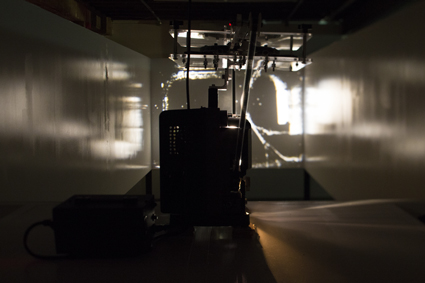 |
Situated Cinema, artists Solomon Nagler and Alexandre Larose photo Louise M Cooper |
In Canadian filmmakers Solomon Nagler and Alexandre Larose’s Situated Cinema at Artspace three screens capture the projected image, one visible, a second invisible and another out of action (a different kind of signification, more later).
The visible screen is translucent, the image projected onto it a larger version of the same image on the 16mm acetate film strip inexorably looping through the projector standing a few metres away. The image on the screen is indistinct; attention switches to the machinery creating this phantasm. At one time the standard audio-visual equipment hidden in the biobox of a lecture theatre or community hall, the 16mm film projector mounted on a plinth is here re-presented as an object of analogue marvel; complete with perspex film loop attachment, the visible process by which the picture is delivered to our eyes becomes one part of the event.
The other event is provided by the images on the screen; they possess none of the indicators associated with either popular or arthouse films; instead, the genre rarely afforded exposure in cinema settings, the home movie. The ensemble, the installation, for those old enough to remember, recalls family film shows. The reprocessed images, evidently a selection of moments from various filmic occasions, possess a banal innocence when people are present, recorded moving through the scene, or responding shyly to the presence of the camera. We in turn are present at a specific moment of encounter with a past presence, reliving what has long gone by.
Moments later (counted as 24 frames for each second; we can hear them), the people have gone and a landscape or scene of the city and suburb becomes something other, the uncanny, the familiar yet incongruous. The cognitive event is made tangible, momentarily, before being hustled on to the next occasion…Back then.
We have encountered loops in projected work before; somehow the duration of these—about four minutes—seems to match with the cognitive ability of short-term memory (STM) to productively revisit motion picture documentation of ‘insignificant actuality.’ The minutiae of moments become fixed points in a matrix of cycled time; as they successively pass by, like lines in a poem, checked for details missed in the first or successive viewings. Our level of obsessiveness is tested and demonstrated before our eyes, our movement into the lives of others drawn out from behind the curtains of privacy imposed by accepted decorum.
The invisible screen is contained in its own walled area; the only way to gain access is by ducking beneath the wooden wall into the wholly enclosed space, thus transgressing the usually lubricated entrance to cinema seating arrangements. There are of course no chairs and the space is only big enough for two or three to stand. Momentarily I envisage the spectacle of legs outside this temporary cinema and reflect on whether social cognitive functioning of the audience deviates from the game plan. The 16mm projection equipment is arranged elegantly on a shelf joining the two long sides of the space. The four walls are painted with a white coating reflecting the light from the narrow wall at the end, transgressing the rule whereby light is firmly controlled to sit specifically on white bordered by black. The high contrast imagery is hard to see, as if in a snowfield, but gradually becomes recognisable as a sequence of static images of architecture, washed by the shapes of some associated alchemical process. Memory is interrogated again as the patterns fall together, and the loop completes its cycle, recognisable now as the interior of a theatre or indeed, a cinema. In the background, more amplified than previously, the insistent intermittent purr of the projector.
The third projector contains a short loop of 8mm film fossicked from a Sydney opshop. It ran throughout the period of the exhibition until at its end when this reviewer attended, the loop had disintegrated – another kind of duration had been established within the protocols of projection.
This modest show was unsupported by an adequate curatorial or artists’ statement; we are told the work emerges from primarily ‘materialist’ approaches, but without reference to the title of the show. A case could be made for it fitting into theories of situated aesthetics, where the boundaries between objects and events are weakened such that the art experience is based on a wide distribution of its elements. It would have helped if this ground had been outlined for the audience.
There are many artists now working with film and film equipment both nationally and internationally, often referencing work by film artists of the 1960s and 70s (and earlier) who experimented with an approach to cinema that followed on from the Modernist tradition. Artspace has been operating a reciprocal residency program with the Darling Foundry in Montréal for five years. The Situated Cinema Project had been constructed in Halifax previously, creating small cinematic experiences in dis-used urban spaces (“Situated Cinema references small buildings that have been squeezed into leftover urban spaces. The small cinema space, which can be demounted and which will travel to unorthodox locations…is intended to provide an alternative cinema-going experience,” Solomon Nagler, www.cineflux.ca.) In early discussions of the presentation of the work, the installation likewise was to be off-site, a Sydney-based iteration; but due to the difficulties of working internationally between Canada and Sydney, and the strict nature of urban DA approvals in Sydney, the installation was brought into the gallery space.
Situated Cinema, artists Solomon Nagler and Alexandre Larose, Artspace, Sydney, 22 Feb-8 March
RealTime issue #120 April-May 2014 pg. 55
© Mike Leggett; for permission to reproduce apply to [email protected]








 back
back